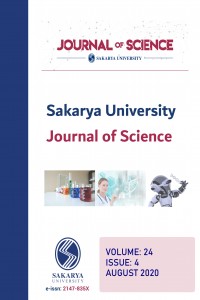Abstract
References
- G. Ranzi and A. Ostinelli, “Ultimate behaviour and design of post-tensioned composite slabs” Engineering Structures, vol. 150, pp. 711-718, 2017.
- J. D. Chaitanya Kumar and L. Venkat, “Genetic algorithm based optimum design of prestressed concrete beam” International Journal of Civil and Structural Engineering, vol. 3, pp.644–654, 2013.
- [P. Fanning, “Nonlinear models of reinforced and posttensioned concrete beams” Electronic Journal of Structural Engineering, vol. 2, pp. 111–119, 2001.
- M. A. Pisani, “Behaviour under long-term loading of externally prestressed concrete beams” Engineering Structures, vol. 160, pp. 24-33, 2018.
- O. F. Hussien, T. H. K. Elafandy, A. A. Abdelrahman, S. A. Abdel Baky, and E. A. Nasr, “Behavior of bonded and unbonded prestressed normal and high strength concrete beams” HBRC Journal, vol. 8, pp. 239–251, 2012.
- M. A. Utrilla and A. Samartin “Optimized design of the prestress in continuous bridge decks” Computers and Structures, vol. 64, issue 1-4, pp. 719-728, 1997.
- M. S.Kim, and Y. H. Lee, “Flexural behavior of posttensioned flat plates depending on tendon layout” Advances in Materials Science and Engineering, vol. 2016, pp. 11, 2016
- A. Ghallab, “Calculating ultimate tendon stress in externally prestressed continuous concrete beams using simplified formulas” Engineering Structures, vol. 46, pp. 417-430, 2013
- W. Marks, W. Trochymiak “The selection of a system of prestressing tendons in hyperstatic beams as a problem of linear integer programming” Structural and Multidisciplinary Optimization, vol. 3, pp. 59-67, 1991
- S. A. Quiroga, U. M. A. Arroyo “Optimization of prestressed concrete bridge decks” Computers & Structures, vol. 41, pp. 553-559, 1991
A Case Study on Two-Span Post-Tensioned Concrete Bridge Decks with Different Span Lengths and Investigation on Prestressing Tendons with Comparisons
Abstract
Post-Tensioned (PT) concrete system is one of the widely used bridge superstructure types because of its better load capacity performance. By increasing load carrying capacities on conventional reinforced concrete structures, PT is considered as an advanced technology in engineering. The aim of this paper is to study on finite element analysis of two-span PT concrete bridge decks with different span lengths. For three different span lengths, two-span bridge decks were investigated. To reduce the self-weight of the deck, at mid spans, deck section was used as voided section and at diaphragm regions, section was used as filled. Two-dimensional Finite Element (FE) deck models were created by frame elements. The FE software package Midas Civil was used. Permanent, transient and time-dependent loading types were considered. Boundary conditions were defined with their real mechanical properties. To balance the deck section stresses, prestressing tendons were used. By iterations, PT tendons layout and types were studied. Interaction between span lengths and PT tendons areas was investigated. Also, different effects on PT tendons were studied and relevant comparisons were submitted. The “best” tendon using was examined for the investigated deck sections. Concluded that optimization on PT tendon areas at bridge deck sections is possible by investigating the main effects on it. Results show that a good optimization enables us to have the optimal PT tendon using with lower cost.
Keywords
References
- G. Ranzi and A. Ostinelli, “Ultimate behaviour and design of post-tensioned composite slabs” Engineering Structures, vol. 150, pp. 711-718, 2017.
- J. D. Chaitanya Kumar and L. Venkat, “Genetic algorithm based optimum design of prestressed concrete beam” International Journal of Civil and Structural Engineering, vol. 3, pp.644–654, 2013.
- [P. Fanning, “Nonlinear models of reinforced and posttensioned concrete beams” Electronic Journal of Structural Engineering, vol. 2, pp. 111–119, 2001.
- M. A. Pisani, “Behaviour under long-term loading of externally prestressed concrete beams” Engineering Structures, vol. 160, pp. 24-33, 2018.
- O. F. Hussien, T. H. K. Elafandy, A. A. Abdelrahman, S. A. Abdel Baky, and E. A. Nasr, “Behavior of bonded and unbonded prestressed normal and high strength concrete beams” HBRC Journal, vol. 8, pp. 239–251, 2012.
- M. A. Utrilla and A. Samartin “Optimized design of the prestress in continuous bridge decks” Computers and Structures, vol. 64, issue 1-4, pp. 719-728, 1997.
- M. S.Kim, and Y. H. Lee, “Flexural behavior of posttensioned flat plates depending on tendon layout” Advances in Materials Science and Engineering, vol. 2016, pp. 11, 2016
- A. Ghallab, “Calculating ultimate tendon stress in externally prestressed continuous concrete beams using simplified formulas” Engineering Structures, vol. 46, pp. 417-430, 2013
- W. Marks, W. Trochymiak “The selection of a system of prestressing tendons in hyperstatic beams as a problem of linear integer programming” Structural and Multidisciplinary Optimization, vol. 3, pp. 59-67, 1991
- S. A. Quiroga, U. M. A. Arroyo “Optimization of prestressed concrete bridge decks” Computers & Structures, vol. 41, pp. 553-559, 1991
Details
| Primary Language | English |
|---|---|
| Subjects | Civil Engineering |
| Journal Section | Research Articles |
| Authors | |
| Publication Date | August 1, 2020 |
| Submission Date | March 25, 2019 |
| Acceptance Date | April 10, 2020 |
| Published in Issue | Year 2020 Volume: 24 Issue: 4 |
Cite
Cited By
INDEXING & ABSTRACTING & ARCHIVING
Bu eser Creative Commons Atıf-Ticari Olmayan 4.0 Uluslararası Lisans kapsamında lisanslanmıştır .


